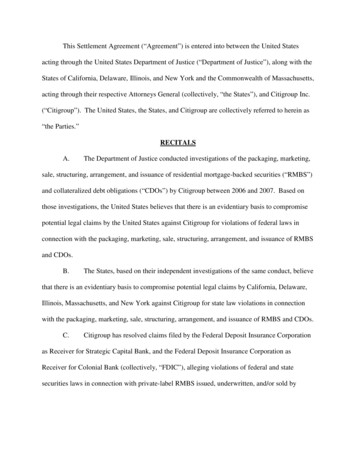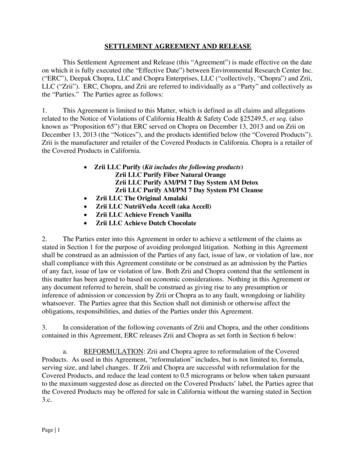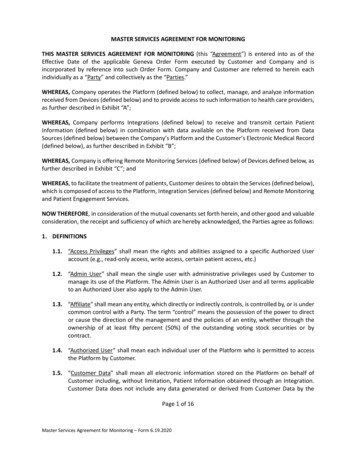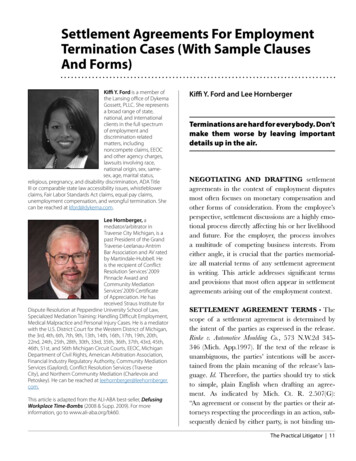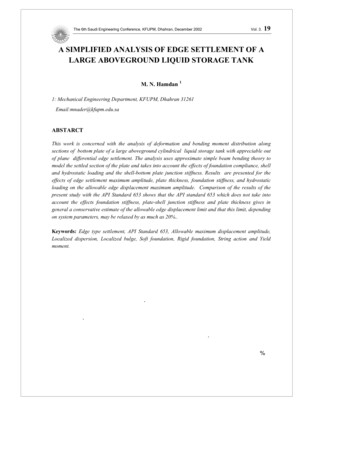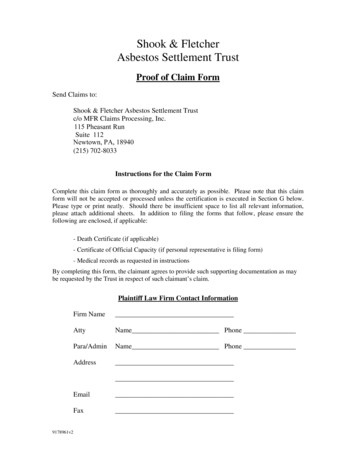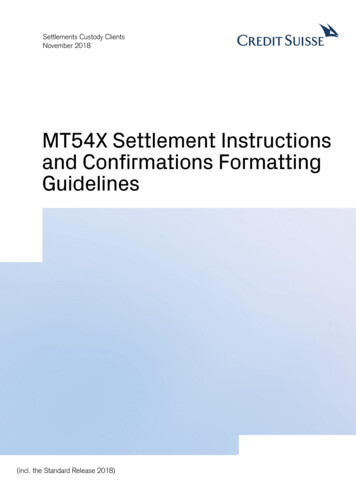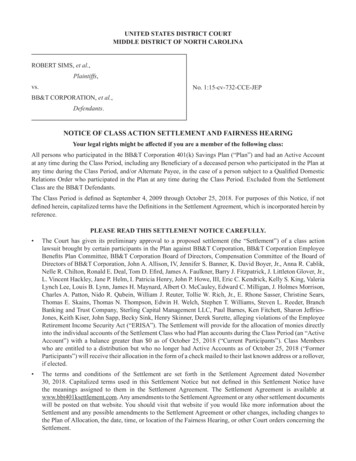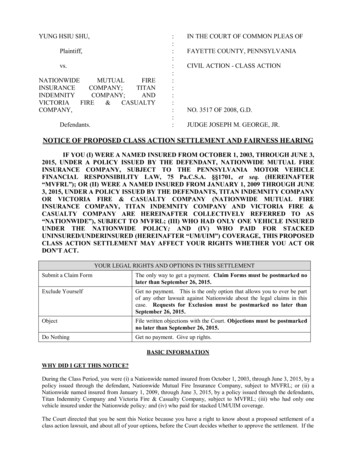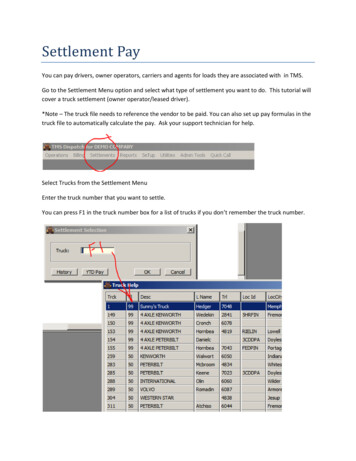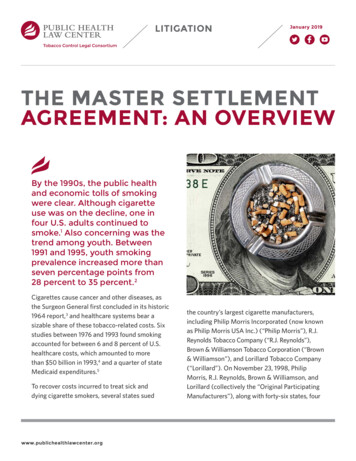
Transcription
LITIGATIONJanuary 2019THE MASTER SETTLEMENTAGREEMENT: AN OVERVIEWBy the 1990s, the public healthand economic tolls of smokingwere clear. Although cigaretteuse was on the decline, one infour U.S. adults continued tosmoke.1 Also concerning was thetrend among youth. Between1991 and 1995, youth smokingprevalence increased more thanseven percentage points from28 percent to 35 percent.2Cigarettes cause cancer and other diseases, asthe Surgeon General first concluded in its historic1964 report,3 and healthcare systems bear asizable share of these tobacco-related costs. Sixstudies between 1976 and 1993 found smokingaccounted for between 6 and 8 percent of U.S.healthcare costs, which amounted to morethan 50 billion in 1993,4 and a quarter of stateMedicaid expenditures.5To recover costs incurred to treat sick anddying cigarette smokers, several states suedwww.publichealthlawcenter.orgthe country’s largest cigarette manufacturers,including Philip Morris Incorporated (now knownas Philip Morris USA Inc.) (“Philip Morris”), R.J.Reynolds Tobacco Company (“R.J. Reynolds”),Brown & Williamson Tobacco Corporation (“Brown& Williamson”), and Lorillard Tobacco Company(“Lorillard”). On November 23, 1998, PhilipMorris, R.J. Reynolds, Brown & Williamson, andLorillard (collectively the “Original ParticipatingManufacturers”), along with forty-six states, four
January 2019U.S. territories, the Commonwealth of Puerto Rico, and the District of Columbia (the “SettlingStates”), entered into the Master Settlement Agreement (MSA), the largest civil litigationsettlement in U.S. history. Later, additional tobacco manufacturers, known as SubsequentParticipating Manufacturers, settled with the states under the MSA. (Original and SubsequentParticipating Manufacturers are referred to collectively as Participating Manufacturers.)As outlined in the MSA, the Settling States released the Participating Manufacturers from past andfuture legal claims for costs incurred by the states for smoking-related illnesses and death and forequitable relief. The release did not include the individual claims of their residents. In exchange,the Participating Manufacturers agreed to make annual payments in perpetuity to the SettlingStates and to substantially restrict their advertising, promotion, and marketing of cigarettes.This publication answers frequently asked questions about the MSA and its implications forpublic health.6 For more information, including additional publications and resources, see thePublic Health Law Center’s website or the National Association of Attorneys General’s website.Q: What was the focus of the litigation?A: From the mid-1950s through 1994, individuals brought over 800 claims against cigarettemanufacturers for damages related to the effects of smoking.7 However, the manufacturers,raising defenses such as contributory negligence and the individual responsibility of smokers,generally prevailed in these lawsuits. In 1994, a number of states, beginning with Mississippi,8sued the largest cigarette manufacturers under a variety of legal theories, including stateconsumer protection and antitrust laws, arguing that cigarettes contributed to health problemsthat triggered significant costs to state health-care systems. In 1997, four states (Mississippi,9Minnesota,10 Florida, and Texas), reached settlements to recover for Medicaid and other healthexpenses resulting from smoking-caused illnesses. (These states are referred to collectively inthe MSA as the “Previously Settled States.”) After these settlements, the major manufacturers,facing a growing number of suits by other states,11 joined with those states and petitionedCongress for a global resolution in June 1997. Congress failed to pass the global settlementagreement, but the manufacturers and the Settling States were still able to reach a settlementin November of the following year: the Master Settlement Agreement.12Q: Who is party to the MSA?A: The MSA is a settlement agreement between the Settling States, the Original ParticipatingManufacturers, and the Subsequent Participating Manufacturers.13 The number of ParticipatingManufacturers remains fluid as, over the years, some additional manufacturers have settledwith the states and others have gone out of business. As of October 2018, there are more than50 Participating Manufacturers who are bound by the terms of the MSA.14www.publichealthlawcenter.orgThe Master Settlement Agreement: An Overview2
January 2019Q: Why did the parties agree to settle?A: According to the first section of the MSA, the parties settled “to avoid the further expense,delay, inconvenience, burden and uncertainty of continued litigation (including appeals fromany verdicts).”15 The Settling States intended the MSA to further their “policies designed toreduce Youth smoking, to promote the public health and to secure monetary payments tothe Settling States.”16 The MSA settles only state and local government lawsuits; the tobaccoindustry gains no protection from class-action lawsuits and claims brought by individuals, laborunions, and private health-care insurers.17www.publichealthlawcenter.orgThe Master Settlement Agreement: An Overview3
January 2019Q: How much does the MSA require the Participating Manufacturers to pay theSettling States?A: The MSA set up initial, annual, and “strategic contribution” payments from ParticipatingManufacturers to the Settling States. Each year, an independent auditor calculates the settlementpayment to be made by each Participating Manufacturer and the amount to be received by eachSettling State.18 If parties disagree with the auditor’s calculations, the matter is submitted tobinding arbitration by three neutral arbitrators who must be former federal judges.19{{{{Initial payments. In addition to annual payments beginning on April 15, 2000, the MSArequired Participating Manufacturers to make upfront payments in each of the first fiveyears after the MSA’s execution, or a total of about 12.75 billion, adjusted for the volumeof cigarette shipments in those years compared to the volume in 1997.20Annual payments (made in perpetuity). Just as the Settling States’ Medicaid and otherhealth-care costs due to their citizens’ smoking-related illnesses will likely continueindefinitely, the MSA provides that the Participating Manufacturers’ payments to theSettling States will continue in perpetuity.21 The “base amounts” of these annual paymentsgradually increase from 2000 to 2018 and remain at the 2018 amount in perpetuity. Theamounts were 4.5 billion in 2000, 5.0 billion in 2001, 6.5 billion from 2002–2003, 8.14billion from 2008–2017, and 9 billion in 2018 and each subsequent year in perpetuity.Participating Manufacturers pay billions of dollars annually to the Settling States. Forexample, in 2018 the Participating Manufacturers paid close to 7.2 billion to the SettlingStates. As of July 2018, the Participating Manufacturers have paid over 126 billion to theSettling States.22 The Settling States receive an allocation of these payments based on apercentage set forth in Exhibit A to the MSA. Importantly, calculations of annual paymentsare complex and are subject to a variety of potential adjustments and offsets, including aninflation adjustment and a volume adjustment.23 Most significantly, percentage reductionsin cigarette shipment volumes have been greater than inflation adjustments since 1997,so actual annual payments have been lower than those set forth as base amounts in theMSA and can be expected to continue to be. Participating Manufacturers are required tomake annual payments based on their shares of national cigarette sales and shipments.In addition, Participating Manufacturers have routinely withheld payments or made theminto an escrow account pending resolution of disputes relating to certain of the abovementioned adjustments. Settling States receive an allocation of these payments based on apercentage set forth in Exhibit A to the MSA.www.publichealthlawcenter.orgThe Master Settlement Agreement: An Overview4
January 2019{{Strategic Contribution Payments. These payments serve as “bonus payments” for statesthat invested resources into the litigation that led to the MSA. The payments are allocatedaccording to the percentages set forth in Exhibit U to the MSA, which were based on “eachSettling State’s contribution to the litigation or resolution of state tobacco litigation.”24 TheParticipating Manufacturers’ base Strategic Contribution Payment amount is 861 millioneach year from 2008 to 2017,25 subject to the same adjustments as the annual payments.26Q: What else does the MSA do?A: The MSA restricts specific conduct by Participating Manufacturers, including advertisingand certain lobbying activities, creates a national tobacco control foundation, and dismantlesseveral tobacco industry initiatives. Specifically:{{It imposes significant prohibitions and restrictions on tobacco advertising, marketing andpromotional programs or activities.27 For example, it prohibits or restricts:]]Direct and indirect targeting of youth]]Use of cartoon characters]]{{Billboards, transit ads, and other outdoor advertising not in direct proximity to a retailestablishment that sells tobacco products]]Product placements in entertainment media]]Free tobacco product samples (except in adult-only facilities)]]Gifts to youth in exchange for proofs of purchase]]Branded merchandise]]Brand name sponsorshipsIt prohibits certain practices that seek to hide negative information about smoking, such as:]]Lobbying against particular kinds of tobacco control legislation and administrative rules28]]Agreements to suppress health-related research]]Material misrepresentations about health consequences of using tobacco29www.publichealthlawcenter.orgThe Master Settlement Agreement: An Overview5
January 2019{{It creates a tobacco prevention foundation and disbands tobacco-industry initiatives]]]]{{The MSA created the American Legacy Foundation (now known as the Truth Initiative),a research and educational organization that focuses its efforts on preventing teensmoking and encouraging smokers to quit. The foundation is responsible for “The Truth”advertisement campaign,30 which has had success in reducing youth smoking.31The MSA dismantled key tobacco industry initiatives, including The Center for Indoor AirResearch,32 The Tobacco Institute,33 and The Council for Tobacco Research.34 In additionto disbanding these specific centers, the MSA prohibits Participating Manufacturersfrom creating other industry-wide groups unless such groups agree to act consistentlywith the MSA’s provisions.35It requires the Participating Manufacturers to make available online the non-privilegeddocuments they disclosed during the discovery phase of the tobacco litigation, as well asany such documents produced in discovery in any federal or state civil action concerningsmoking and health.36www.publichealthlawcenter.orgThe Master Settlement Agreement: An Overview6
January 2019Q: How are the restrictions on the cigarette companies enforced?A: Under Section VII of the MSA, each Settling State may bring an action to enforce theAgreement or the Consent Decree (the settlement contained in a court order) with respectto disputes or alleged breaches within its territory. The court that entered a Settling State’sConsent Decree has exclusive jurisdiction to implement and enforce the MSA with respectto that state. Section VIII(a) of the MSA places responsibility on the National Associationof Attorneys General (NAAG) to coordinate and facilitate the MSA’s implementation andenforcement on behalf of the attorneys general of the Settling States. NAAG carries out thismandate through an attorney general-level Tobacco Committee and an Enforcement WorkingGroup, which consists of attorney general office staff working on tobacco issues, and theNAAG Tobacco Project, which is comprised of staff attorneys within NAAG who support stateenforcement efforts. (The NAAG Tobacco Project is now known as the NAAG Center for Tobaccoand Public Health.) Enforcement typically begins when a state attorney general office or NAAGobserves a potential violation of the MSA, or a member of the public or a public organizationcomplains about a Participating Manufacturer’s marketing practices to a state attorney generalor NAAG. If the matter is not resolved through negotiation, one or more Settling States maydecide to bring an enforcement action against the Participating Manufacturer.Q: What remedies do states have for violations of the MSA?A: The Settling States have several remedies for addressing MSA violations:{{{{Voluntary cessation. Often a desire to avoid litigation can induce companies to abandonchallenged marketing campaigns. The U.S. Smokeless Tobacco Company, for instance,withdrew a false statement about product safety after the Rhode Island Attorney Generalordered the company to desist in 1999.37 Brown and Williamson discontinued its “B-Kool”campaign in 2000 after being investigated jointly by a number of states.38Litigation. Some of the MSA’s provisions contain ambiguities or gaps that have led tolitigation. These have included, for example, the issues of whether free matchbooks are“merchandise” under the MSA,39 whether magazine advertisements are intended to targetyouth,40 and whether the prohibition on brand-name sponsored events has been violated.41If the plaintiff state prevails, it can seek:]]Injunctive relief. Though several Participating Manufacturers amended their advertisingpractices in the wake of the multi-state backlash against the B-Kool campaign, R.J.Reynolds did not make similar substantial changes. As a result, California sued thecompany and the court ordered Reynolds, among other things, to take reasonablemeasures to reduce youth exposure to its advertising.42www.publichealthlawcenter.orgThe Master Settlement Agreement: An Overview7
January 2019]]]]Monetary remedies. These could range from investigative costs43 to funds
THE MASTER SETTLEMENT AGREEMENT: AN OVERVIEW. www.publichealthlawcenter.org The Master Settlement Agreement: An Overview 2 U.S. territories, the Commonwealth of Puerto Rico, and the District of Columbia (the “Settling States”), entered into the Master Settlement Agreement (MSA), the largest civil litigation settlement in U.S. history. Later, additional tobacco manufacturers, known as .
